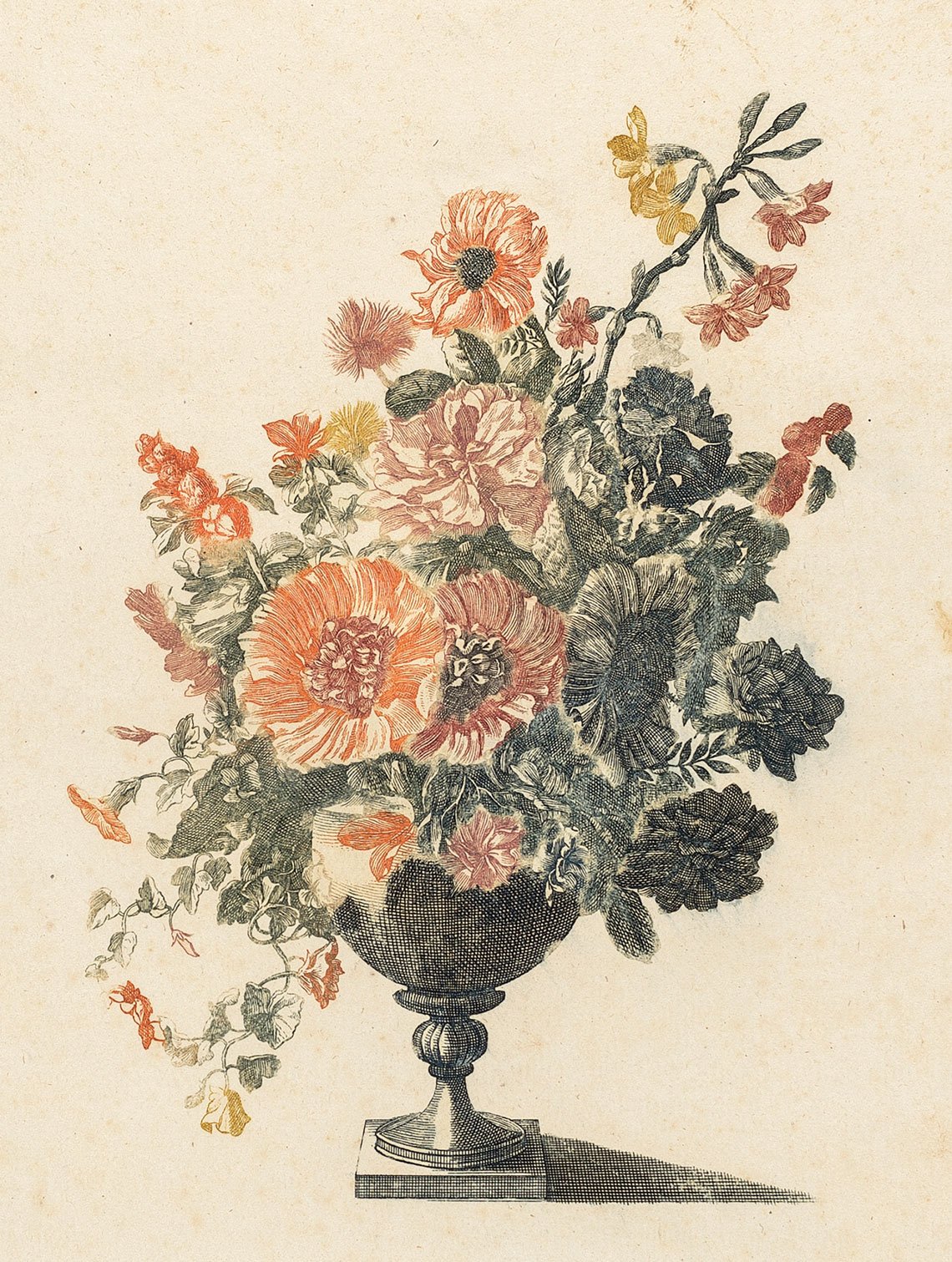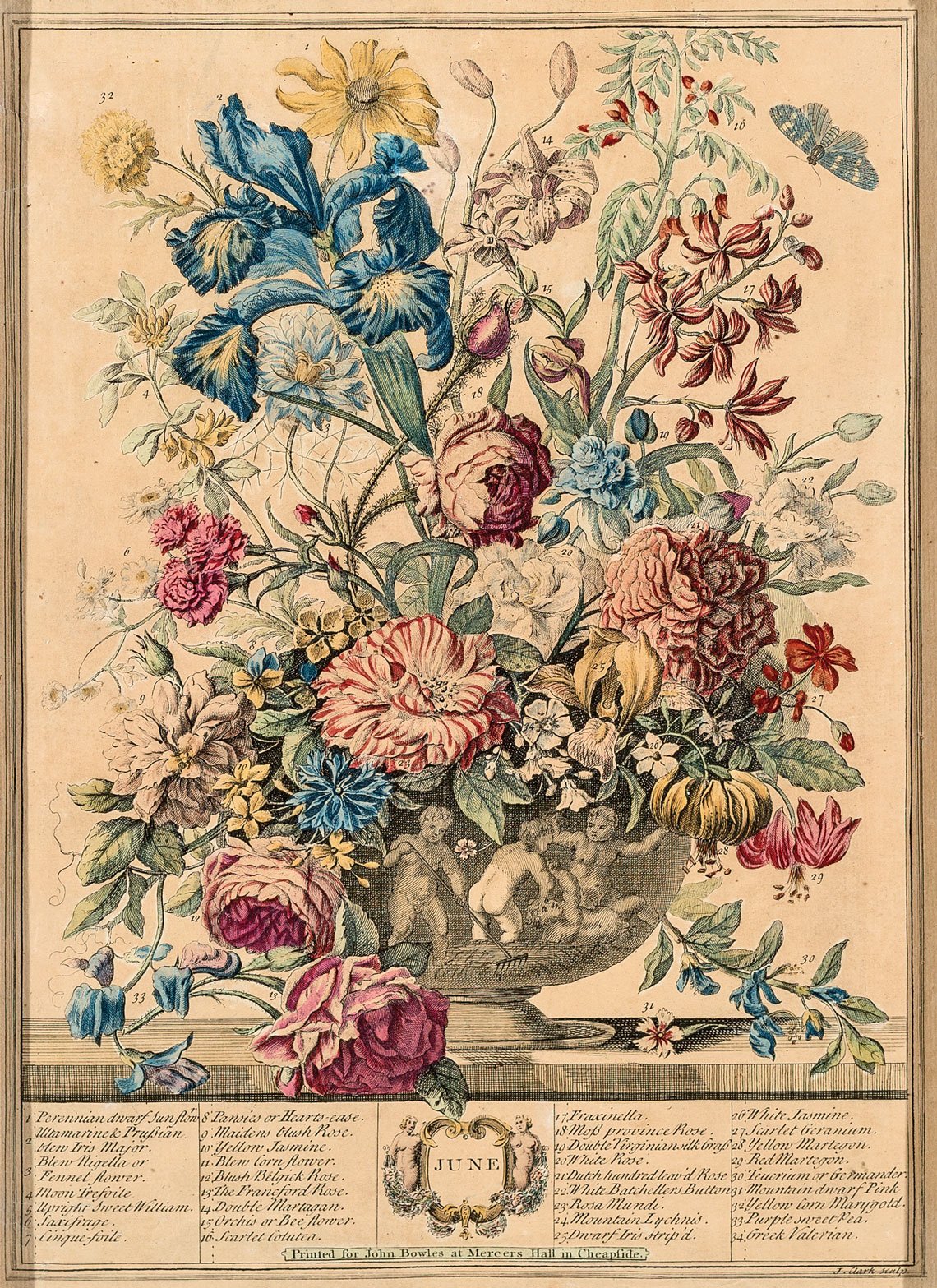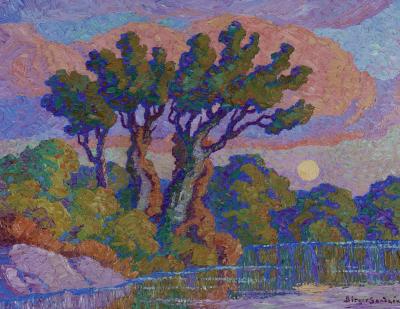Blossoming Prints: The Proliferation of the Dutch Flower Still Life
Winterthur Primer
The floral still life genre of painting emerged in sixteenth-century Europe and developed into one of the most popular artistic products of seventeenth-century Holland. Dutch flower paintings functioned as decorative images, specimens for scientific investigation, and as representations of the brevity of life. They became so admired over the next two centuries that prints reproducing specific Dutch floral still life paintings circulated on the Continent, in England, and throughout the New World.
Jan van Huysum (1682–1749) represented the culmination of the Dutch flower still life tradition that relied on detailed, naturalistic depictions of nature. However, his artful bouquets employed asymmetrical arrangements that mixed exotic and local flowers from different seasons, yielding lush, imaginative combinations, often gathered in a classicizing vase. His paintings had many admirers and imitators throughout the eighteenth and nineteenth centuries and reached a wide audience through prints.
Austrian printmaker Johann Peter Pichler (1765–1807) created two mezzotints representing van Huysum’s lavish compositions in rich tones and delicate surfaces (Figs. 1, 2). Pichler made these prints in Vienna where he spent the majority of his career and where he likely saw one of the source paintings by van Huysum, Flower Still Life with Bird’s Nest, which was then part of the famous Czernin collection (today in the Scottish National Gallery).1
 |  | |
| Figs. 1, 2: Johann Peter Pichleer (1765-1807), Still life with flowers and bird’s nest and Still life with flowers and fruit, after Jan van Huysum (1682–1749), early-nineteenth century. Mezzotints, 23½ x 17½ inches. Winterthur Museum (1994.0110.001-002). | ||
Until the late nineteenth century, most floral illustrations were printed in black and white, and sometimes hand painted for lavishly illustrated botanical books. Printing in colored inks allowed for more vibrancy than hand coloring. It is no surprise that some of the earliest experiments with color printing produced botanical and floral illustrations.
The workshop of Dutch printmaker and inventor Johannes Teyler (1648–ca. 1709) used a pioneering color printing technique to create etchings of fashionable flower still life bouquets, published for public consumption. A Bouquet in a Black Urn and A Bouquet in a Brown Urn (Figs. 3, 4) demonstrate Teyler’s innovative method of printing “à la poupée,” where colored ink was selectively applied to the copper plate. These and hundreds of other prints produced in Teyler’s workshop represented the first flourishing of true intaglio color printing in the West.2
 |  | |
| Figs. 3, 4: Johannes Teyler (1648–ca. 1709), A Bouquet in a Black Urn and A Bouquet in a Brown Urn, after Jean-Baptiste Monnoyer (1636–1699), late-seventeenth century. Etchings printed in colors, 6½ x 4½ inches. Winterthur Museum (2017.0005.001-002, details). | ||
Like Pichler, Teyler’s workshop of engravers and designers often took their inspiration from existing paintings. These prints imitate flower bouquets composed by Jean-Baptiste Monnoyer (1636–1699), a Flemish painter whose designs juxtaposed foreign and familiar flora, such as the tropical pink mallow and northern rose found in the Black Urn. However, the printed colors did not necessarily match Monnoyer’s original designs, and Teyler’s plates were not inked uniformly for subsequent impressions.3 Thus, Teyler’s technique made each impression unique, creating a “printed painting” despite using a reproductive medium. Teyler’s prints, with their dazzling colors, exotic subjects and beautiful designs were even collected internationally in his own lifetime.
The portability and affordability of prints allowed for the circulation of floral still lifes not only throughout Europe but also in the American colonies. Eighteenth-century American advertisements, inventories, and journals record the importation, sale, and display of such prints, and Winterthur holds several examples.4 Colored prints in the Dutch tradition appear in the 1740 journal of Colonel William Stephens as he recorded the sale of Thomas Christie’s household goods in Savannah, noting “a few common Dutch printed Pictures coloured on Paper.” 5
We can trace a set of Dutch flower still life prints from its creation in Europe to its display in colonial America. In 1730, British nurseryman Robert Furber commissioned Flemish still life artist Pieter Casteels III (1648–1749) to paint twelve canvases commemorating the months of the year in flowers.6 A commercial venture, Furber had engravings made after the paintings and sold each luxury set as both a decorative calendar and advertisement for his sale of plant seeds. The prints were so popular that copies appeared within a few years to meet the high demand for fanciful flower pictures. One such copy, Flora, published by John Bowles in London in 1745, featured a set of thirteen etchings after Casteels’ original designs, with one bouquet per month, plus a title page introducing the pleasures of the garden (Figs. 5, 6). Each print labeled and grouped the flowers according to the month in which they bloomed. Many of these calendar sets depicting Casteels’ designs hung in colonial American homes, including the Massachusetts bedroom of Andrew Belcher inventoried in 1771.7
 |  | |
| Figs. 5, 6: J. Clark and Thomas Bowles (ca. 1712–ca. 1753), JUNE and MARCH, after Pieter Casteels III (1648–1749), 1745. Line etched with minimal burin work and hand colored, 14 x 10 inches. Winterthur Museum (1966.1048.003 and 1966.1048.006). | ||
In addition to their decorative function, these images fed the curiosity of both European and American consumers. The print media allowed for a wider circulation of scientific ideas, encouraging amateurs in the technical study of botanical subjects. A 1756 advertisement from the Pennsylvania Gazette demonstrated both the scientific and ornamental appeal of floral prints: “This Day is published, A Catalogue of a curious collection of Prints: consisting of several hundred representations of Trees, Shrubs, Plants, Herbs, Fruits, Flowers &c. all in their prime state: Delineated from the real plants, &c. and neatly coloured after nature. Being well adapted for furniture, and ornamenting of apartments, closets &c., like-wise fit for japanning, or to serve for patterns for drawing embroidery &c. divided into lots . . .” 8
Thus, printed still lifes could be considered accurate, if exotic; each bud rendered naturalistically even if the arrangement proved artificial. Prized for their duality of technical description and aesthetic invention, these images contained flora from all over Europe, America and even the East. In particular, the commercial nature of the Casteels commission reflected the global scope of botanical study and agricultural trade, and the importation of the associated prints also embodied this exchange.
Elizabeth Simmons is a doctoral candidate in the department of art history at the University of Delaware. Previously, she served as the Graduate Assistant in the Museum Collections Department at Winterthur where she researched these prints as part of an Art Works grant from the National Endowment for the Arts to digitize the collection of works on paper.
More Winterthur Primer articles are available by searching Incollect or can be found in one location at Winterthur.org.
This article was originally published in the 18th Anniversary issue of Antiques & Fine Art magazine, a fully digitized edition of which is available at www.afamag.com. AFA is affiliated with Incollect.
2. Simon Turner, “Opus typo-chromaticum: The Colour Prints of Johannes Teyler,” in Printing in Colour 1400–1700, eds. Ad Stijnman and Elizabeth Savage (Leiden: Brill, 2015), 196–206.
3. Compare with impressions in the British Museum (1871,1209.5125), Library of Congress (LCCN 49040185, pp. 91, 97), and Rijksmuseum (RP-P-1955-288).
4. For more on the circulation of European prints in colonial America, see Joan Dolmetsch, “European Prints in Eighteenth-Century America,” Antiques 101:5 (May 1972): 858–63; E. McSherry Fowble, “To Please Every Taste: Prints for the American Market,” in Two centuries of prints in America, 1680–1880: a selective catalogue of the Winterthur Museum collection (Charlottesville: University Press of Virginia, 1987), 3–31.
5. Allen Daniel Candler et al., Stephens’ Journal, 1737–1740, Colonial Records of the State of Georgia, vol. 4 (Atlanta: Franklin Print. and Pub. Co., 1904), 450.
6. The twelve paintings sold at Christie’s, New York, on May 25, 2005.
7. E. McSherry Fowble, To Please Every Taste: Eighteenth-Century Prints from the Winterthur Museum (Alexandria, Va.: Art Services International, 1991, 174–177), 224–227.
8. “This Day is published, A Catalogue of a curious collection of Prints…,” Pennsylvania Gazette, September 9, 1756, 3.































